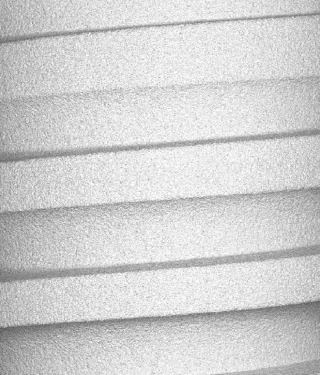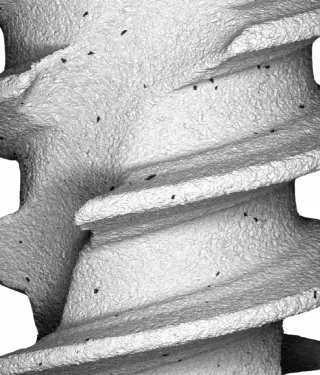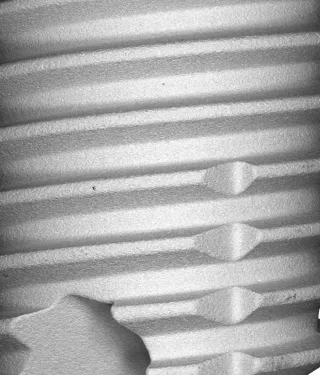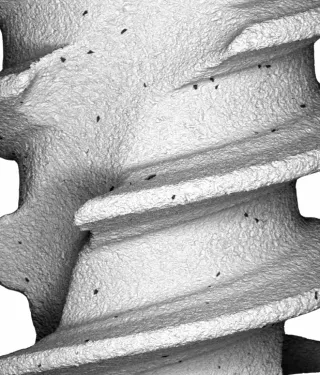
Why TiUltra™ surfaces?
Because you deserve real science
Predictability
TiUltra™ surface is backed by science and proven for predictability
Decades of research. A wealth of clinical science and evidence. Not every implant on the market comes with this level of proof.
In a systematic review by Prof. Ann Wennerberg et al.1, Nobel Biocare anodized surface implants show the highest survival rate, compared to other surfaces after a 10-year of follow-up. Prof. Tomas Albrektsson in his recent study2 reports on the successful outcome of Nobel Biocare's anodized implants after 20 years.
Yes – 20 years of clinical data is why we believe in anodized surfaces.
But we don’t stop there. Using that knowledge, we push the boundaries even further. TiUltra surface was launched in 2019, as a premium hybrid surface to answers real clinical needs.
The topography of the TiUltra ultra-hydrophilic surface gradually changes, from a non-porous and minimally rough surface at the coronal part of implant to a moderately rough surface at the apical part. Today, TiUltra surface is clinically proven in 12 clinical studies3-14– including one with more than 1,000 enrolled patients.14,15
Discover more in our latest white paper>
Because when science leads the way, implant success follows.
Surface cleanliness
Anodization and sand-blasting and acid-etching are currently the main surface modification techniques which are used for most of the available implant systems in the market.
Both anodization and sand-blasting and acid-etching processing of implant surfaces increase the roughness of machined titanium from initial roughness average (Sa) of ≤0.5 𝜇m to 1−2 𝜇m. This improves the survival rate of implants showing the highest survival rate of implants with anodized surface.1
Do you want to know how different implants surfaces look under the microscope?
In a study published in International Journal of Biomaterials, Prof. Peter Schupbach et al. analyzed morphology and cleanliness of different sand-blasted and acid-etched implant systems.16 9 implant systems (6 samples per group) were investigated using scanning electron microscopy and energy dispersive X-ray spectroscopy. Many implants had particle remnants from the blasting process. The authors highlighted the need for better control of the sand-blasting and acid-etching process to ensure clean and consistent implant surfaces.
Backscatter-SEM micrographs of the analyzed implant systems. Note the Al2O3 particles (black dots) remaining on the surface following etching. Scale bar: 200 μm. Copyright © 2019 Shupbach et al.
We believe that when it comes to implant success, cleanliness isn’t optional – it’s essential.
Unlike sand-blasting and acid-etching surfaces, TiUltra is not a subtractive surface. This means the risk of contamination with sand-blasting particles is zero.
Not all implant surfaces are created equal!
Fewer complications
Consensus reports, meta-analyses and systematic reviews struggle to pinpoint the prevalence of peri-implantitis, with estimates ranging from 10% to 40%.17,18 But one thing every clinician in dental practice agrees on: managing peri-implantitis complications—especially when rough surfaces are exposed—demands expertise and experience.
That's why TiUltra surface was designed with the future in mind, as Dr. Pedro Peña says.
With more than 35 years of clinical experience and research, he now focuses on education, and treating complex referral cases in his practice, many involving patients who received their implants over 20 years ago.
According to Dr. Peña, TiUltra is the only implant surface with a true hybrid design, featuring a gradual change in roughness in the intrabony zone.
This design features a non-porous and minimally rough surface on the upper part of the implant to prevent peri-implantitis if the coronal part is exposed to bacteria. Towards the apex, the surface becomes moderately rough and porous to improve interlocking between the bone cells and the implant, which is essential for better clinical outcomes in immediate loading or soft bone.
TiUltra™ surface is backed by science you can trust
When researching, innovating, and bringing solutions to market, we prioritize patient safety and clinical predictability in real-world clinical practice.
At Nobel Biocare, we let science speak and we back each and every innovation with rigorous research, peer-reviewed studies, and clinical evidence.
Because when it comes to patient care, only real science delivers real results.
Discover more>
Curious about TiUltra surface real science? Connect with your representative to learn more.
Nobel Biocare believes you and your patient deserve the real science.
- Learn more on Xeal™ and TiUltra™
- Clinical outcomes with TiUltra™ surfaces
- Performance of Xeal™ and TiUltra™ surfaces in peer-reviewed publications
- “Nothing can replace a proper clinical study and clinical documentation”
- How do hydrophilic surfaces speed up the healing process?
- SciConnect, where patient-centric innovations and clinical science meet
- Discover our story based on over 65 years’ R&D in implantology
References
- Wennerberg A, Albrektsson T, Chrcanovic B. Long-term clinical outcome of implants with different surface modifications. Eur J Oral Implantol. 2018;11 Suppl 1:S123-S136.
Read on Pubmed - Östman PO, Chrcanovic BR, Albrektsson T. A Prospective Report of the Clinical Outcome of TiUnite Implants at 20 Years of Follow-up. Int J Oral Maxillofac Implants. 2024 Jun 21;(3):389-395.
Read on Pubmed - Fabbri G, Ban G, Lim H, et al. Robust papilla regeneration and marginal bone gain: 2-Year results from a prospective study. Clin Oral Impl Res;34(S27):159-160.
Read online - Ferro A, De Araújo Nobre M. All-on-4 concept using TiUltra surface implants and Multi-unit Xeal abutments: Report on the outcomes between 6 to 36 months. Clin Oral Impl Res;34(S27):137-138.
Read online - Fabbri G, Staas T, Urban I. A Retrospective Observational Study Assessing the Clinical Outcomes of a Novel Implant System with Low-Speed Site Preparation Protocol and Tri-Oval Implant Geometry. J Clin Med. 2022 Aug 18;11(16):4859.
Read on Pubmed - Pozzi A, Arcuri L, Kan J, et al. Navigation guided socket-shield technique for implant and pontic sites in the esthetic zone: A proof-of-concept 1-year prospective study with immediate implant placement and loading. J Esthet Restor Dent. 2022 Jan;34(1):203-214.
Read on Pubmed - Pozzi A, Hansson L, Carosi P, et al. Dynamic navigation guided surgery and prosthetics for immediate loading of complete-arch restoration. J Esthet Restor Dent. 2021 Jan;33(1):224-236.
Read on Pubmed - Battista E, Gasparro R, Cacciola M, et al. Dynamic Navigation System for Immediate Implant Placement in the Maxillary Aesthetic RegionApplied Sciences. 2022;12(11):5510.
Read online - Bahat O, Yin X, Holst S, et al. An Osteotomy Tool That Preserves Bone Viability: Evaluation in Preclinical and Clinical Settings. J Clin Med. 2022 Apr 30;11(9):2536.
Read online - Urban IA, Tattan M, Ravida A, et al. Simultaneous Alveolar Ridge Augmentation and Periodontal Regenerative Therapy Leveraging Recombinant Human Platelet-Derived Growth Factor-BB (rhPDGF-BB): A Case Report. Int J Periodontics Restorative Dent. 2022 September/October;42(5):577–585.
Read on Pubmed - Babayan M, Bidra AS. Management of bleeding during dental implant surgery using a novel implant with an abbreviated drilling protocol: A clinical report. J Prosthodont. 2024 Mar;33(3):206-211.
Read on Pubmed - Gamborena I, Sasaki Y, Blatz MB. Transmucosal abutments in the esthetic zone: Surgical and prosthetic considerations. J Esthet Restor Dent. 2023 Jan;35(1):148-157.
Read on Pubmed - Donker VJJ, Raghoebar GM, Vissink A, Meijer HJA. Digital Workflow for Immediate Implant Placement and Chairside Provisionalization in the Esthetic Zone. Case Rep Dent. 2022 Apr 1;2022:5114332.
Read on Pubmed - Miguel Roig Cayón et al. Real-world study with 1000 patients treated with gradually anodized surface implants: Initial results.Clin Oral Impl Res;34(S27):167-168.
Read online - Eshraghi et al. Evaluation of gradually anodized surface on four implant systems. A prospective, thousand-patient realworld study. AO2024.
Read online - Schupbach P, Glauser R, Bauer S. Al2O3 Particles on Titanium Dental Implant Systems following Sandblasting and Acid-Etching Process. Int J Biomater. 2019 Jun 2;2019:6318429.
Read on Pubmed - Diaz P, Gonzalo E, Villagra LJG, Miegimolle B, Suarez MJ. What is the prevalence of peri-implantitis? A systematic review and meta-analysis. BMC Oral Health. 2022 Oct 19;22(1):449.
Read on Pubmed - Rokaya D, Srimaneepong V, Wisitrasameewon W, Humagain M, Thunyakitpisal P. Peri-implantitis Update: Risk Indicators, Diagnosis, and Treatment. Eur J Dent. 2020 Oct;14(4):672-682.
Read on Pubmed













Is real science important to you? Then, stay tuned and don’t miss the latest surface science updates!